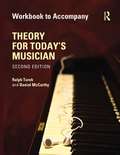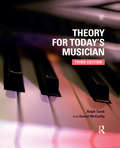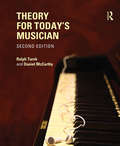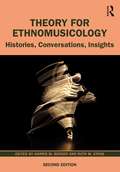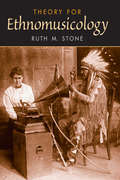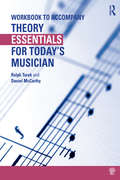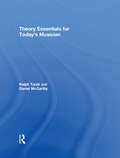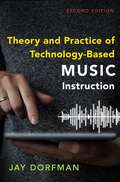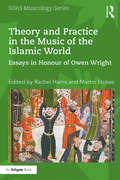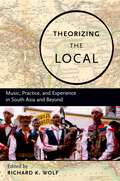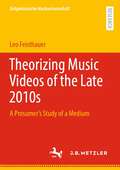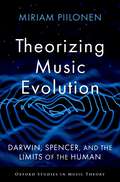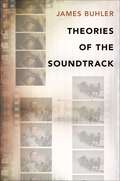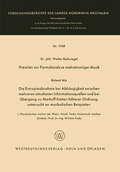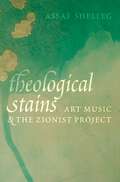- Table View
- List View
Theory for Today's Musician Workbook, Second Edition (eBook)
by Ralph Turek Daniel McCarthyThe package (ISBN 978-0-415-73036-5) contains the second edition of Theory for Today’s Musician (ISBN: 978-0-415-66332-8) and the Theory for Today’s Musician Workbook (ISBN: 978-0-415-66333-5). The package is available for print books only. Ebook users should purchase the textbook and workbook separately. This workbook accompanies the second edition of Theory for Today's Musician and is full of exercises to help students practice and master the concepts presented in each chapter. Audio files are included.
Theory for Today's Musician Workbook, Second Edition (eBook)
by Ralph Turek Daniel McCarthyThe package (ISBN 978-0-415-73036-5) contains the second edition of Theory for Today’s Musician (ISBN: 978-0-415-66332-8) and the Theory for Today’s Musician Workbook (ISBN: 978-0-415-66333-5). The package is available for print books only. Ebook users should purchase the textbook and workbook separately. This workbook accompanies the second edition of Theory for Today's Musician and is full of exercises to help students practice and master the concepts presented in each chapter. Audio files are included.
Theory for Today's Musician Textbook, Third Edition
by Ralph Turek Daniel McCarthyTheory for Today’s Musician, Third Edition, recasts the scope of the traditional music theory course to meet the demands of the professional music world, in a style that speaks directly and engagingly to today’s music student. It uses classical, folk, popular, and jazz repertoires with clear explanations that link music theory to musical applications. The authors help prepare students by not only exploring how music theory works in art music, but how it functions within modern music, and why this knowledge will help them become better composers, music teachers, performers, and recording engineers. This broadly comprehensive text merges traditional topics such as part writing and harmony (diatonic, chromatic, neo-tonal and atonal), with less traditional topics such as counterpoint and musical process, and includes the non-traditional topics of popular music songwriting, jazz harmony and the blues. The accompanying companion website provides interactive exercises that allow students to practice foundational theory skills. Written by experienced authors, both active classroom teachers for many years, Theory for Today’s Musician is the complete and ideal theory text to enable today’s student to accomplish their musical goals tomorrow. Updated and corrected throughout, the Third Edition includes: Expanded coverage of atonality and serialism, now separated into two chapters. Broadened treatment of cadences, including examples from popular music. Substantially rewritten chapter on songwriting. Interactive features of the text simplified to two types, "Concept Checks" and "Review and Reinforcement," for greater ease of use. New and updated musical examples added throughout. Charts, illustrations, and musical examples revised for increased clarity. Audio of musical examples now provided through the companion website. The accompanying Workbook offers exercises and assignments to accompany each chapter in the book. A companion website houses online tutorials with drills of basic concepts, as well as audio.
Theory for Today's Musician
by Ralph Turek Daniel McCarthyThe package (ISBN 978-0-415-73036-5) contains the second edition of Theory for Today’s Musician (ISBN: 978-0-415-66332-8) and the Theory for Today’s Musician Workbook (ISBN: 978-0-415-66333-5). The package is available for print books only. Ebook users should purchase the textbook and workbook separately. Theory for Today’s Musician, Second Edition, recasts the scope of the traditional music theory course to meet the demands of the professional music world, in a style that speaks directly and engagingly to today’s music student. It uses classical, folk, popular, and jazz repertoires with clear explanations that link music theory to musical applications. The authors help prepare students by not only exploring how music theory works in art music, but how it functions within modern music, and why this knowledge will help them become better composers, music teachers, performers, and recording engineers. This broadly comprehensive text merges traditional topics such as part-writing and harmony (diatonic, chromatic, neo-tonal and atonal), with less traditional topics such as counterpoint and musical process, and includes the non-traditional topics of popular music songwriting, jazz harmony and the blues. Written by an experienced textbook author and new co-author, both active classroom teachers for many years, Theory for Today’s Musician is the complete and ideal theory text to enable today’s student to accomplish their musical goals tomorrow. New Features to the Second Edition: An expanded unit on form that includes introductory chapters on sonata & rondo, to prepare students for learning form New "Back to Basics" online drills, keyed to the text, allowing students to brush up their fundamentals as needed New musical examples, including over 80 new musical excerpts from both art and popular music repertoires Expanded in-chapter exercises to promote and facilitate classroom interaction Carefully edited in response to market demands to create a more streamlined, flexible text New audio of musical examples (for both text and workbook), 50% re-recorded for improved audio quality An updated and relocated Chapter 33 on song composition in the jazz and popular folk styles, applying principles of text setting, melody composition/harmonization Companion website that houses online tutorial with drills of basic concepts
Theory for Today's Musician
by Ralph Turek Daniel McCarthyThe package (ISBN 978-0-415-73036-5) contains the second edition of Theory for Today’s Musician (ISBN: 978-0-415-66332-8) and the Theory for Today’s Musician Workbook (ISBN: 978-0-415-66333-5). The package is available for print books only. Ebook users should purchase the textbook and workbook separately. Theory for Today’s Musician, Second Edition, recasts the scope of the traditional music theory course to meet the demands of the professional music world, in a style that speaks directly and engagingly to today’s music student. It uses classical, folk, popular, and jazz repertoires with clear explanations that link music theory to musical applications. The authors help prepare students by not only exploring how music theory works in art music, but how it functions within modern music, and why this knowledge will help them become better composers, music teachers, performers, and recording engineers. This broadly comprehensive text merges traditional topics such as part-writing and harmony (diatonic, chromatic, neo-tonal and atonal), with less traditional topics such as counterpoint and musical process, and includes the non-traditional topics of popular music songwriting, jazz harmony and the blues. Written by an experienced textbook author and new co-author, both active classroom teachers for many years, Theory for Today’s Musician is the complete and ideal theory text to enable today’s student to accomplish their musical goals tomorrow. New Features to the Second Edition: An expanded unit on form that includes introductory chapters on sonata & rondo, to prepare students for learning form New "Back to Basics" online drills, keyed to the text, allowing students to brush up their fundamentals as needed New musical examples, including over 80 new musical excerpts from both art and popular music repertoires Expanded in-chapter exercises to promote and facilitate classroom interaction Carefully edited in response to market demands to create a more streamlined, flexible text New audio of musical examples (for both text and workbook), 50% re-recorded for improved audio quality An updated and relocated Chapter 33 on song composition in the jazz and popular folk styles, applying principles of text setting, melody composition/harmonization Companion website that houses online tutorial with drills of basic concepts
Theory for Ethnomusicology: Histories, Conversations, Insights
by Harris M. Berger Ruth M. StoneTheory for Ethnomusicology: Histories, Conversations, Insights, Second Edition, is a foundational work for courses in ethnomusicological theory. The book examines key intellectual movements and topic areas in social and cultural theory, and explores the way they have been taken up in ethnomusicological research. New co-author Harris M. Berger and Ruth M. Stone investigate the discipline’s past, present, and future, reflecting on contemporary concerns while cataloging significant developments since the publication of the first edition in 2008. A dozen contributors approach a broad range of theoretical topics alive in ethnomusicology. Each chapter examines ethnographic and historical works from within ethnomusicology, showcasing the unique contributions scholars in the field have made to wider, transdisciplinary dialogs, while illuminating the field’s relevance and pointing the way toward new horizons of research. New to this edition: Every chapter in the book is completely new, with richer and more comprehensive discussions. New chapters have been added on gender and sexuality, sound and voice studies, performance and critical improvisation studies, and theories of participation. New text boxes and notes make connections among the chapters, emphasizing points of contact and conflict among intellectual movements.
Theory for Ethnomusicology: Histories, Conversations, Insights
by Harris M. Berger Ruth M. StoneTheory for Ethnomusicology: Histories, Conversations, Insights, Second Edition, is a foundational work for courses in ethnomusicological theory. The book examines key intellectual movements and topic areas in social and cultural theory, and explores the way they have been taken up in ethnomusicological research. New co-author Harris M. Berger and Ruth M. Stone investigate the discipline’s past, present, and future, reflecting on contemporary concerns while cataloging significant developments since the publication of the first edition in 2008. A dozen contributors approach a broad range of theoretical topics alive in ethnomusicology. Each chapter examines ethnographic and historical works from within ethnomusicology, showcasing the unique contributions scholars in the field have made to wider, transdisciplinary dialogs, while illuminating the field’s relevance and pointing the way toward new horizons of research. New to this edition: Every chapter in the book is completely new, with richer and more comprehensive discussions. New chapters have been added on gender and sexuality, sound and voice studies, performance and critical improvisation studies, and theories of participation. New text boxes and notes make connections among the chapters, emphasizing points of contact and conflict among intellectual movements.
Theory for Ethnomusicology
by Ruth M. StoneFor courses in ethnomusicological theory. This book covers ethnomusicological theory, exploring some of the underpinnings of different approaches and analyzing differences and commonalities in these orientations. This text addresses how ethnomusicologists have used and applied these theories in ethnographic research.
Theory for Ethnomusicology
by Ruth M. StoneFor courses in ethnomusicological theory. This book covers ethnomusicological theory, exploring some of the underpinnings of different approaches and analyzing differences and commonalities in these orientations. This text addresses how ethnomusicologists have used and applied these theories in ethnographic research.
Theory Essentials for Today's Musician (Workbook)
by Ralph Turek Daniel McCarthyTheory Essentials for Today’s Musician offers a review of music theory that speaks directly and engagingly to modern students. Rooted in the tested pedagogy of Theory for Today’s Musician, the authors have distilled and reorganized the concepts from the thirty-three chapters of their original textbook into twenty-one succinct, modular chapters that move from the core elements of harmony to further topics in form and 20th-century music. A broad coverage of topics and musicals styles—including examples drawn from popular music—is organized into four key parts: Basic Tools Chromatic Harmony Form and Analysis The 20th Century and Beyond Theory Essentials features clear and jargon-free (yet rigorous) explanations appropriate for students at all levels, ensuring comprehension of concepts that are often confusing or obscure. An accompanying workbook provides corresponding exercises, while a companion website presents streaming audio examples. This concise and reorganized all-in-one package—which can be covered in a single semester for a graduate review, or serve as the backbone for a briefer undergraduate survey—provides a comprehensive, flexible foundation in the vital concepts needed to analyze music. PURCHASING OPTIONS Textbook and Workbook Package (Paperback): 9781138098756 Textbook Only (Hardback): 9781138708815 Textbook Only (Paperback): 9781138708822 Textbook Only (eBook): 9781315201122 Workbook Only (Paperback): 9781138098749 Workbook Only (eBook): 9781315103839
Theory Essentials for Today's Musician (Workbook): Workbook
by Ralph Turek Daniel McCarthyTheory Essentials for Today’s Musician offers a review of music theory that speaks directly and engagingly to modern students. Rooted in the tested pedagogy of Theory for Today’s Musician, the authors have distilled and reorganized the concepts from the thirty-three chapters of their original textbook into twenty-one succinct, modular chapters that move from the core elements of harmony to further topics in form and 20th-century music. A broad coverage of topics and musicals styles—including examples drawn from popular music—is organized into four key parts: Basic Tools Chromatic Harmony Form and Analysis The 20th Century and Beyond Theory Essentials features clear and jargon-free (yet rigorous) explanations appropriate for students at all levels, ensuring comprehension of concepts that are often confusing or obscure. An accompanying workbook provides corresponding exercises, while a companion website presents streaming audio examples. This concise and reorganized all-in-one package—which can be covered in a single semester for a graduate review, or serve as the backbone for a briefer undergraduate survey—provides a comprehensive, flexible foundation in the vital concepts needed to analyze music. PURCHASING OPTIONS Textbook and Workbook Package (Paperback): 9781138098756 Textbook Only (Hardback): 9781138708815 Textbook Only (Paperback): 9781138708822 Textbook Only (eBook): 9781315201122 Workbook Only (Paperback): 9781138098749 Workbook Only (eBook): 9781315103839
Theory Essentials for Today's Musician (Textbook)
by Ralph Turek Daniel McCarthyTheory Essentials for Today’s Musician offers a review of music theory that speaks directly and engagingly to modern students. Rooted in the tested pedagogy of Theory for Today’s Musician, the authors have distilled and reorganized the concepts from the thirty-three chapters of their original textbook into twenty-one succinct, modular chapters that move from the core elements of harmony to further topics in form and 20th-century music. A broad coverage of topics and musicals styles—including examples drawn from popular music—is organized into four key parts: Basic Tools Chromatic Harmony Form and Analysis The 20th Century and Beyond Theory Essentials features clear and jargon-free (yet rigorous) explanations appropriate for students at all levels, ensuring comprehension of concepts that are often confusing or obscure. An accompanying workbook provides corresponding exercises, while a companion website presents streaming audio examples. This concise and reorganized all-in-one package—which can be covered in a single semester for a graduate review, or serve as the backbone for a briefer undergraduate survey—provides a comprehensive, flexible foundation in the vital concepts needed to analyze music. PURCHASING OPTIONS Textbook and Workbook Package (Paperback): 9781138098756 Textbook Only (Hardback): 9781138708815 Textbook Only (Paperback): 9781138708822 Textbook Only (eBook): 9781315201122 Workbook Only (Paperback): 9781138098749 Workbook Only (eBook): 9781315103839
Theory Essentials for Today's Musician (Textbook): Workbook
by Ralph Turek Daniel McCarthyTheory Essentials for Today’s Musician offers a review of music theory that speaks directly and engagingly to modern students. Rooted in the tested pedagogy of Theory for Today’s Musician, the authors have distilled and reorganized the concepts from the thirty-three chapters of their original textbook into twenty-one succinct, modular chapters that move from the core elements of harmony to further topics in form and 20th-century music. A broad coverage of topics and musicals styles—including examples drawn from popular music—is organized into four key parts: Basic Tools Chromatic Harmony Form and Analysis The 20th Century and Beyond Theory Essentials features clear and jargon-free (yet rigorous) explanations appropriate for students at all levels, ensuring comprehension of concepts that are often confusing or obscure. An accompanying workbook provides corresponding exercises, while a companion website presents streaming audio examples. This concise and reorganized all-in-one package—which can be covered in a single semester for a graduate review, or serve as the backbone for a briefer undergraduate survey—provides a comprehensive, flexible foundation in the vital concepts needed to analyze music. PURCHASING OPTIONS Textbook and Workbook Package (Paperback): 9781138098756 Textbook Only (Hardback): 9781138708815 Textbook Only (Paperback): 9781138708822 Textbook Only (eBook): 9781315201122 Workbook Only (Paperback): 9781138098749 Workbook Only (eBook): 9781315103839
Theory and Practice of Technology-Based Music Instruction: Second Edition
by Jay DorfmanTechnology is an increasingly popular part of music education in schools that attracts students to school music who might not otherwise be involved. In many teacher preparation programs, music technology is an afterthought that does not receive the same extensive treatment as do traditional areas of music teaching such as band, orchestra, choir, and general music. This book helps to establish a theoretical and practical foundation for how to teach students to use technology as the major means for developing their musicianship. Including discussions of lesson planning, lesson delivery, and assessment, readers will learn how to gain comfort in the music technology lab. Theory and Practice of Technology-Based Music Instruction also includes "profiles of practice" that dive into the experiences of real teachers in music technology classes, their struggles, their successes, and lessons we can learn from both. In this second edition, new profiles feature Teachers of Color who use technology extensively in their varied types of music teaching. This edition encourages readers to think about issues of inequity of social justice in music education technology and how teachers might begin to address those concerns. Also updated are sections about new standards that may guide music education technology practice, about distance and technology-enhanced learning during the global pandemic, and about ways to integrate technology in emerging contexts.
Theory and Practice of Technology-Based Music Instruction: Second Edition
by Jay DorfmanTechnology is an increasingly popular part of music education in schools that attracts students to school music who might not otherwise be involved. In many teacher preparation programs, music technology is an afterthought that does not receive the same extensive treatment as do traditional areas of music teaching such as band, orchestra, choir, and general music. This book helps to establish a theoretical and practical foundation for how to teach students to use technology as the major means for developing their musicianship. Including discussions of lesson planning, lesson delivery, and assessment, readers will learn how to gain comfort in the music technology lab. Theory and Practice of Technology-Based Music Instruction also includes "profiles of practice" that dive into the experiences of real teachers in music technology classes, their struggles, their successes, and lessons we can learn from both. In this second edition, new profiles feature Teachers of Color who use technology extensively in their varied types of music teaching. This edition encourages readers to think about issues of inequity of social justice in music education technology and how teachers might begin to address those concerns. Also updated are sections about new standards that may guide music education technology practice, about distance and technology-enhanced learning during the global pandemic, and about ways to integrate technology in emerging contexts.
Theory and Practice in the Music of the Islamic World: Essays in Honour of Owen Wright (SOAS Studies in Music Series)
by Rachel Harris Martin StokesThis volume of original essays is dedicated to Owen Wright in recognition of his formative contribution to the study of music in the Islamic Middle East. Wright’s work, which comprises, at the time of writing, six field-defining volumes and countless articles, has reconfigured the relationship between historical musicology and ethnomusicology. No account of the transformation of these fields in recent years can afford to ignore his work. Ranging across the Middle East, Central Asia and North India, this volume brings together historical, philological and ethnographic approaches. The contributors focus on collections of musical notation and song texts, on commercial and ethnographic recordings, on travellers’ reports and descriptions of instruments, on musical institutions and other spaces of musical performance. An introduction provides an overview and critical discussion of Wright’s major publications. The central chapters cover the geographical regions and historical periods addressed in Wright’s publications, with particular emphasis on Ottoman and Timurid legacies. Others discuss music in Greece, Iraq and Iran. Each explores historical continuities and discontinuities, and the constantly changing relationships between music theory and practice. An edited interview with Owen Wright concludes the book and provides a personal assessment of his scholarship and his approach to the history of the music of the Islamic Middle East. Extending the implications of Wright’s own work, this volume argues for an ethnomusicology of the Islamic Middle East in which past and present, text and performance are systematically in dialogue.
Theory and Practice in the Music of the Islamic World: Essays in Honour of Owen Wright (SOAS Studies in Music Series)
by Rachel Harris Martin StokesThis volume of original essays is dedicated to Owen Wright in recognition of his formative contribution to the study of music in the Islamic Middle East. Wright’s work, which comprises, at the time of writing, six field-defining volumes and countless articles, has reconfigured the relationship between historical musicology and ethnomusicology. No account of the transformation of these fields in recent years can afford to ignore his work. Ranging across the Middle East, Central Asia and North India, this volume brings together historical, philological and ethnographic approaches. The contributors focus on collections of musical notation and song texts, on commercial and ethnographic recordings, on travellers’ reports and descriptions of instruments, on musical institutions and other spaces of musical performance. An introduction provides an overview and critical discussion of Wright’s major publications. The central chapters cover the geographical regions and historical periods addressed in Wright’s publications, with particular emphasis on Ottoman and Timurid legacies. Others discuss music in Greece, Iraq and Iran. Each explores historical continuities and discontinuities, and the constantly changing relationships between music theory and practice. An edited interview with Owen Wright concludes the book and provides a personal assessment of his scholarship and his approach to the history of the music of the Islamic Middle East. Extending the implications of Wright’s own work, this volume argues for an ethnomusicology of the Islamic Middle East in which past and present, text and performance are systematically in dialogue.
Theorizing the Local: Music, Practice, and Experience in South Asia and Beyond
by Richard WolfOver the past four decades, the "globalized" aspects of cultural circulation have received the majority of scholarly-and consumer-attention, particularly in the study of South Asian music. As a result, a broad range of community-based and other locally focused performance traditions in the regions of South Asia have remained relatively unexplored. Theorizing the Local provides a challenging and compelling counterperspective to the "globalized," arguing for the value of comparative microstudies that are not concerned primarily with the flow of capital and neoliberal politics. What does it mean for musical activities to be local in an increasingly interconnected world? To what extent can theoretical activity be localized to the very acts of making music, interacting, and composing? Theorizing the Local offers glimpses into rich musical worlds of south and west Asia, worlds which have never before been presented in a single volume. The authors cross the traditional borders of scholarship and region, exploring in unmatched detail a vast array of musical practices and significant ethnographic discoveries-from Nepal to India, India to Sri Lanka, Pakistan to Iran. Enriched by audio and video tracks on an extensive companion Web site, Theorizing the Local is an important study of South Asian musical traditions that offers a broader understanding of 21st-century music of the world.
Theorizing Music Videos of the Late 2010s: A Prosumer’s Study of a Medium (Zeitgenössische Musikwissenschaft)
by Leo FeisthauerThe work formulates a status quo of the music video medium in the late 2010s and shows which trends, aesthetics and (new) standards have established themselves. Particularly the role of the prosumer amidst evolved technical conditions is highlighted in this context, which strongly influences the evolution of music video in this period. Moreover, the author understands music videos as socio-political actors and examines the resulting questions of their interaction with culture.
Theorizing Music Evolution: Darwin, Spencer, and the Limits of the Human (Oxford Studies in Music Theory)
by Miriam PiilonenWhat did historical evolutionists such as Charles Darwin and Herbert Spencer have to say about music? What role did music play in their evolutionary theories? What were the values and limits of these evolutionist turns of thought, and in what ways have they endured in present-day music research? Theorizing Music Evolution: Darwin, Spencer, and the Limits of the Human is a critical examination of ideas about musical origins, emphasizing nineteenth-century theories of music in the evolutionist writings of Darwin and Spencer. Author Miriam Piilonen argues for the significance of this Victorian music-evolutionism in light of its ties to a recently revitalized subfield of evolutionary musicology. Taking an interdisciplinary approach to music theorizing, Piilonen explores how historical thinkers constructed music in evolutionist terms and argues for an updated understanding of music as an especially fraught area of evolutionary thought. In this book, Piilonen delves into how historical evolutionists, in particular Darwin and Spencer, developed and applied a concept of music that served as a boundary-drawing device, used to trace or obscure the conceptual borders between human and animal. She takes as primary texts the early evolutionary treatises that double as theoretical accounts of music's origins. For Darwin, music served as a kind of proto-language common to humans and animals alike; he heard the songs of birds and the chirps of mice as musical, as articulated in texts such as The Descent of Man (1871) and The Expression of the Emotions in Man and Animals (1872). Spencer, on the other hand, viewed music as a specifically human stage of evolutionary advance, beyond language acquisition, as outlined in his essay, "The Origin and Function of Music" (1857). These competing views established radically different perspectives on the origin and function of music in human cultural expression, while at the same time being mutually constitutive of one another. A ground-breaking contribution to music theory and histories of science, Theorizing Music Evolution turns to music evolution with an eye toward disrupting and intervening in these questions as they recur in the present.
Theorizing Music Evolution: Darwin, Spencer, and the Limits of the Human (Oxford Studies in Music Theory)
by Miriam PiilonenWhat did historical evolutionists such as Charles Darwin and Herbert Spencer have to say about music? What role did music play in their evolutionary theories? What were the values and limits of these evolutionist turns of thought, and in what ways have they endured in present-day music research? Theorizing Music Evolution: Darwin, Spencer, and the Limits of the Human is a critical examination of ideas about musical origins, emphasizing nineteenth-century theories of music in the evolutionist writings of Darwin and Spencer. Author Miriam Piilonen argues for the significance of this Victorian music-evolutionism in light of its ties to a recently revitalized subfield of evolutionary musicology. Taking an interdisciplinary approach to music theorizing, Piilonen explores how historical thinkers constructed music in evolutionist terms and argues for an updated understanding of music as an especially fraught area of evolutionary thought. In this book, Piilonen delves into how historical evolutionists, in particular Darwin and Spencer, developed and applied a concept of music that served as a boundary-drawing device, used to trace or obscure the conceptual borders between human and animal. She takes as primary texts the early evolutionary treatises that double as theoretical accounts of music's origins. For Darwin, music served as a kind of proto-language common to humans and animals alike; he heard the songs of birds and the chirps of mice as musical, as articulated in texts such as The Descent of Man (1871) and The Expression of the Emotions in Man and Animals (1872). Spencer, on the other hand, viewed music as a specifically human stage of evolutionary advance, beyond language acquisition, as outlined in his essay, "The Origin and Function of Music" (1857). These competing views established radically different perspectives on the origin and function of music in human cultural expression, while at the same time being mutually constitutive of one another. A ground-breaking contribution to music theory and histories of science, Theorizing Music Evolution turns to music evolution with an eye toward disrupting and intervening in these questions as they recur in the present.
Theories of the Soundtrack (Oxford Music/Media Series)
by James BuhlerA theory of the soundtrack is concerned with what belongs to the soundtrack, how a soundtrack is effectively organized, how its status in a multimedia object affects the nature of the object, the tools available for its analysis, and the interpretive regime that the theory mandates for determining the meaning, sense, and structure that sound and music bring to film and other audiovisual media. Beyond that, a theory may also delineate the range of possible uses of sound and music, classify the types of relations that films have used for image and sound, identify the central problems, and reflect on and describe effective uses of sound in film. This book summarizes and critiques major theories of the soundtrack from roughly 1929 until today. Rather than providing an exhaustive historical survey, it sketches out the range of theoretical approaches that have been applied to the soundtrack since the commercial introduction of the sound film. The basic theoretical framework of each approach is presented, taking into account the explicit and implicit claims about the soundtrack and its relation to other theories. The organization is both chronological and topical, the former in that the chapters move steadily from early film theory through models of the classical system to more recent critical theories; the latter in that the chapters highlight central issues for each generation: the problem of film itself, then of image and sound, of adequate analytical-descriptive models, and finally of critical-interpretative models.
Theories of the Soundtrack (Oxford Music/Media Series)
by James BuhlerA theory of the soundtrack is concerned with what belongs to the soundtrack, how a soundtrack is effectively organized, how its status in a multimedia object affects the nature of the object, the tools available for its analysis, and the interpretive regime that the theory mandates for determining the meaning, sense, and structure that sound and music bring to film and other audiovisual media. Beyond that, a theory may also delineate the range of possible uses of sound and music, classify the types of relations that films have used for image and sound, identify the central problems, and reflect on and describe effective uses of sound in film. This book summarizes and critiques major theories of the soundtrack from roughly 1929 until today. Rather than providing an exhaustive historical survey, it sketches out the range of theoretical approaches that have been applied to the soundtrack since the commercial introduction of the sound film. The basic theoretical framework of each approach is presented, taking into account the explicit and implicit claims about the soundtrack and its relation to other theories. The organization is both chronological and topical, the former in that the chapters move steadily from early film theory through models of the classical system to more recent critical theories; the latter in that the chapters highlight central issues for each generation: the problem of film itself, then of image and sound, of adequate analytical-descriptive models, and finally of critical-interpretative models.
Theorien zur Formalanalyse mehrstimmiger Musik: Die Entropieabnahme bei Abhängigkeit zwischen mehreren simultanen Informationsquellen und bei Übergang zu Markoff-Ketten höherer Ordnung, untersucht an musikalischen Beispielen (Forschungsberichte des Landes Nordrhein-Westfalen #1768)
by Walter ReckziegelDer vorliegende Bericht stützt sich auf die Arbeiten von WILHELM PUCKS und baut auf den Methoden und Ergebnissen des genannten Autors auf. Die Kenntnis der im Verzeichnis angeführten Literatur darf vorausgesetzt werden. Die im Text erwähnten statistischen Begriffe (Mittelwert, Streuung etc. ) wurden von FUCKS zur Untersuchung musikalischer Elemente benutzt. Er stellte eine Reihe von Analysen an, indem er zunächst die relative Häufigkeit der Tonhöhen einstimmiger Melodien (Violin- und Flötenstimmen, Gesangs-Oberstimmen aus klassischen Werken von etwa 1500 bis heute) berechnete. Es wurde gezeigt, daß die Streuung und die Entropie der Zahlenwerte unabhängig voneinander proportional zur Entstehungszeit der Musik monoton ansteigen. Sodann wurden Intervalle zwischen je zwei benachbarten Tönen gebildet und ebenfalls deren Häufigkeit ausgezählt. Da hier die Streuung wegen der qualitativen Gleichheit oktavversetzter Töne als Hilfsmittel unbrauchbar ist, wurde die Kyrtosis der Zahlenwerte be rechnet. Trägt man die erhaltenen Werte wieder als Punktion der Zeit auf, so erfolgt nur zum Teil ein monotoner Anstieg; eine Gruppe von Zwölftonkompo sitionen dagegen sinkt auffallend tief, sogar noch unter die Werte der Barockzeit und der franko-flämischen Periode, ab. Die sog. Tonhöhenübergangsmatrix in den erwähnten Arbeiten gibt ein anschau liches Bild davon, welche Töne jeweils aufeinander folgen. Vergrößert man den Abstand zwischen den benachbarten Elementen schrittweise um 1, so kann für jeden Abstand q eine weitere Matrix aufgestellt werden. Die Übergangsmatrizen q-ter Ordnung lassen sich durch Korrelationsellipsen ersetzen, die zwischen den Grenzfällen »Parallele Geraden« und »Kreis« alle möglichen Formen annehmen können. Dasselbe Verfahren läßt sich auch auf Intervallpaare anwenden.
Theological Stains: Art Music and the Zionist Project
by Assaf ShellegTheological Stains offers the first in-depth study of the development of art music in Israel from the mid-twentieth century to the turn of the twenty-first. In a bold and deeply researched account, author Assaf Shelleg explores the theological grammar of Zionism and its impact on the art music written by emigrant and native composers. He argues that Israeli art music, caught in the tension between a bibliocentric territorial nationalism on the one hand and the histories of deterritorialized Jewish diasporic cultures on the other, often features elements of both of these competing narratives. Even as composers critically engaged with the Zionist paradigm, they often reproduced its tropes and symbols, thereby creating aesthetic hybrids with 'theological stains.' Drawing on newly uncovered archives of composers' autobiographical writings and musical sketches, Shelleg closely examines the aesthetic strategies that different artists used to grapple with established nationalist representations. As he puts the history of Israeli art music in conversation with modern Hebrew literature, he weaves a rich tapestry of Israeli culture and the ways in which it engaged with key social and political developments throughout the second half of the twentieth century. In analyzing Israeli music and literature against the backdrop of conflicts over territory, nation, and ethnicity, Theological Stains provides a revelatory look at the complex relationship between art and politics in Israel.
